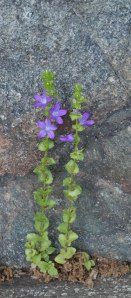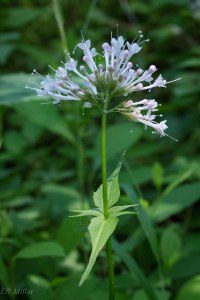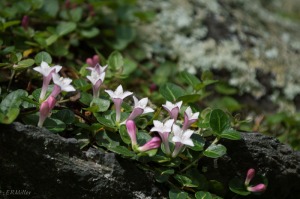
How do I know it’s perfoliate bellwort and not large-flowered bellwort? The bumps inside the petals are one clue.
In yesterday’s post I mentioned that color isn’t the most reliable of characteristics. There are a few other things to beware of. First, matching by pictures doesn’t work as well as you may expect. It will often get you to the right genus, but not always to the species. Second, the guidebooks describe ideals, but plants don’t always grow in ideal conditions. Environmental conditions and stresses can change how a plant looks. Be aware that petals can be missing, especially as a plant nears the end of its blooming period. I’ve found variations in leaf shapes, and one author’s “dentate” might be another author’s “serrate” – and how much of a difference is there between the two terms, anyway?
To identify a flower you need to observe the whole plant. Closely.
This might mean carefully moving other foliage out of the way. A good first step: check that the plant isn’t surrounded by poison ivy or stinging nettles, or that some critter isn’t hiding under or near it. Use a stick rather than sticking your hands in.
It’s best to have a book at hand when you do this. If you don’t, take lots of notes. Measure things when you can. I carry a 3′ tape measure, but you can estimate using what’s on hand, like “one and a half pen lengths”, then measure your pen when you get home. In my experience identifying later from photos is dodgy; often the pictures are missing a critical detail, no matter how thorough I thought I was. For that matter, I usually miss something when taking notes, so again, having a book at hand is best.
What to observe – and this is only a partial list:
The flowers: number of petals, how they’re arranged, their symmetry (bilateral or radial), color, presence or absence of floral scent, size.
How the flowers are borne: singly or in groups? At the end of the stem or along the stem? Coming from the same node as the leaves or not? Are the flowers on little stems (pedicels) or are the flower bases against the main plant stem?
Are the flowers are on the same stem as the leaves, or on a separate stem?
The whole plant: height, branching, arrangement of leaves (alternate, opposite, whorled, basal rosette only), how the leaves attach to the stem, presence of hairs on stem and or leaves, color. Forb, vine, shrub, or tree?
The leaves: are there any? simple or compound? smooth edges, or wrinkled, or toothed? Be careful here, as sometimes a compound leaf is so large and complicated, or the leaflets so well spaced, that you think you’re looking at many simple leaves when actually you’re looking at one large leaf.
Habitat: This is critical. Where is the plant growing? In sun or shade? On a steep slope or in a floodplain? Along a riverbank or even in the water? Swamp plants do not grow on hilltops. Spring ephemerals grow in woodlands, but they bloom and die back before the trees leaf out, so the habitat might be described as partly or mostly sunny despite all the trees.
Season: if the plant normally blooms in May, you might see it blooming in early June (if you found it at the north end of its range), but you probably didn’t see it blooming in August.
Don’t look at just one plant! Have a look around for more of the same, and if you see variations, note them, and also note what seems typical.
Tomorrow: things change; beware the internet.









